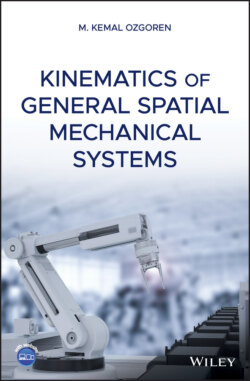Читать книгу Kinematics of General Spatial Mechanical Systems - M. Kemal Ozgoren - Страница 21
1.5 Representation of a Vector in a Selected Reference Frame
ОглавлениеA vector can be resolved in a selected reference frame as shown below.
(1.29)
Owing to the numerical index notation, Eq. (1.29) can also be written compactly as follows:
(1.30)
In Eqs. (1.29) and (1.30), is defined as the kth component of in . It is obtained as
(1.31)
The components of can be stacked as follows to form a column matrix , which is defined as the column matrix representation of the vector in .
(1.32)
In order to show the resolved vector explicitly, may also be denoted as . That is,
(1.33)
The basis vector of is represented by the following column matrix in .
(1.34)
In Eq. (1.34), is the kth basic column matrix, which is defined as shown below for each k ∈ {1, 2, 3}.
(1.35)
Here, it must be pointed out that, just like a scalar, is an entity that is not associated with any reference frame. This is because represents in its own frame , whatever is. In other words,
(1.36)
Moreover, the set of the basic column matrices forms the primary basis of the space of the 3 × 1 column matrices. In other words, any arbitrary column matrix can be expressed as a linear combination of , , and as shown below.
(1.37)
Therefore, being a column matrix, can also be expressed in terms of the basic column matrices , , and by writing the following matrix version of Eq. (1.29) in .
(1.38)
For the sake of comparing Eqs. (1.29) and (1.38) from the viewpoint of the notational logic, Eq. (1.29) is written again below.
(1.39)
Here, it is instructive to pay attention to the interchanged location of the superscript (a) in Eqs. (1.38) and (1.39). In Eq. (1.39), must not bear (a) because it is a vector that is specified without necessarily knowing anything about the observation frame , whereas must necessarily bear (a) because it is one of the basis vectors of . In Eq. (1.38), on the other hand, must necessarily bear (a) because it represents the appearance of as observed in , whereas must not bear (a) because it is not tied up to any reference frame as explained above and expressed by Eq. (1.36).
